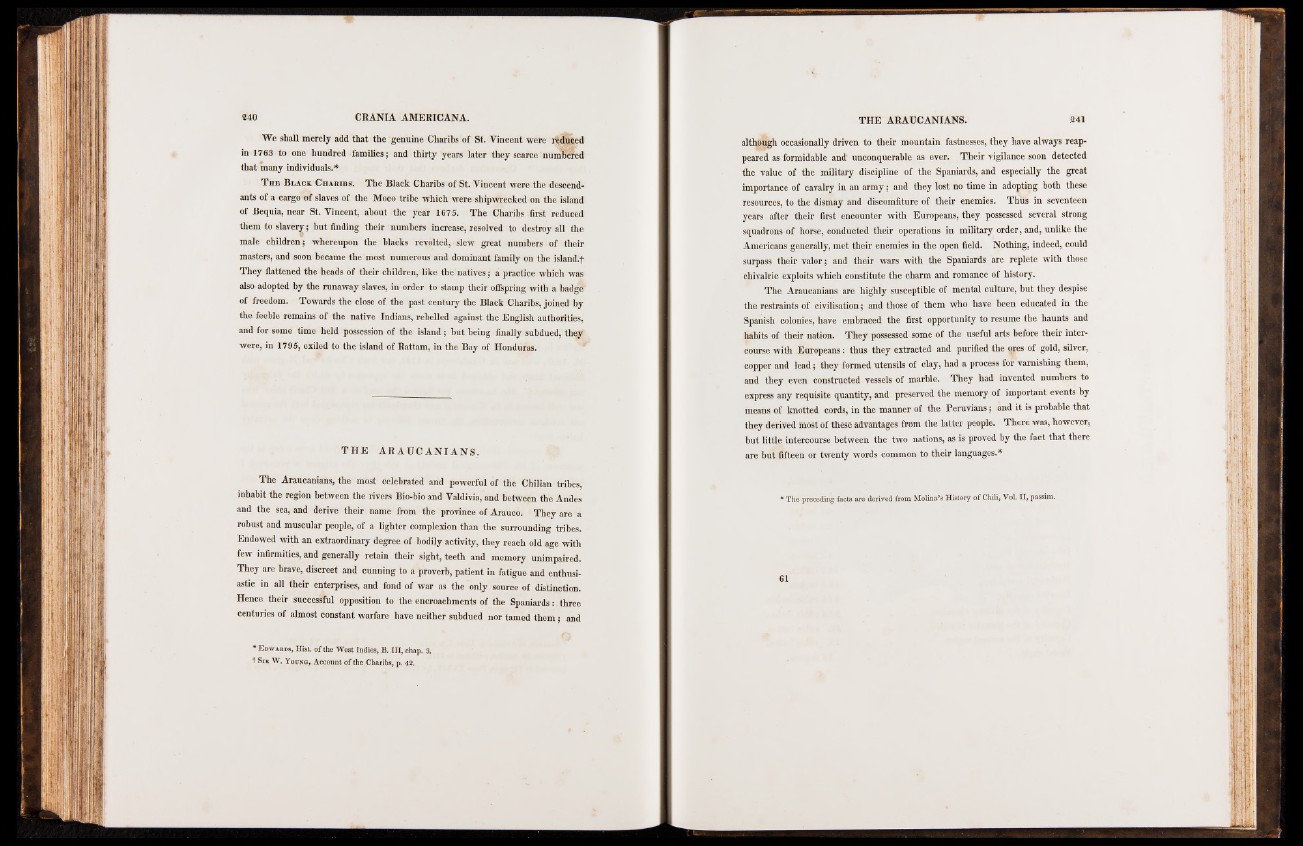
We shall merely add that the genuine Charibs of St. Vincent were reduced
in 1763 to one hundred families; and thirty years later they scarce numfeed
that many individuals.*
T he Black Charibs. The Black Charibs of St. Vincent were the descendants
of a cargo of slaves of the Moco tribe which were shipwrecked on the island
of Bequia, near St. Vincent, about the year 1675. The Charibs first reduced
them to slavery; but finding their numbers increase, resolved to destroy all the
male children; whereupon the blacks revolted, slew great numbers of their
masters, and soon became the most numerous and dominant family on the island.!
They flattened the heads of their children, like the natives; a practice which was
also adopted by the runaway slaves, in order to stamp their offspring with a badgi'
of freedom. Towards the close of the past century the Black Charibs, joined by
the feeble remains of the native Indians, rebelled against the English authorities,
and for some time held possession of the island; but being finally subdued, they
were, in 1795, exiled to the island of Rattam, in the Bay of Honduras.
T H E ARAUCANIANS .
The Araucanians, the most celebrated and powerful of the Chilian tribes,
inhabit the region between the rivers Bio-bio and Valdivia, and between the Andes
and the sea, and derive their name from the province of Arauco. They are a
robust and muscular people, of a lighter complexion than the surrounding tribes.
Endowed with an extraordinary degree of bodily activity, they reach old age with
few infirmities, and generally retain their sight, teeth and memory unimpaired.
They are brave, discreet and cunning to a proverb, patient in fatigue and enthusiastic
in all their enterprises, and fond of war as the only source of distinction.
Hence their successful opposition to the encroachments of the Spaniards: three
centuries of almost constant warfare have neither subdued nor tamed them; and
* E dw ards , Hist, of the West Indies, B. I ll, chap. 3.
t Sir W. Young, Account of the Charibs, p. 42.
although occasionally driven to their mountain fastnesses, they have always reappeared
as formidable and' unconquerable as ever* Their vigilance soon detected
the value of the military discipline of the Spaniards, and especially the great
importance of cavalry in an army; and they lost no time in adopting both these
resources, to the dismay and discomfiture of their enemies. Thus in seventeen
years after their first encounter with Europeans, they possessed several strong
squadrons of horse, conducted their operations in military order, and, unlike the
Americans generally, met their enemies in the open field. Nothing, indeed, could
surpass their valor; and their wars with the Spaniards are replete with those
chivalric exploits which constitute the charm and romance of history.
The Araucanians are highly susceptible of mental culture, but they despise
the restraints of civilisation; and those of them who have been educated in the
Spanish colonies, have embraced the first opportunity to resume the haunts and
habits of their nation. They possessed some of the useful arts before their intercourse
with Europeans: thus they extracted and purified the ores of gold, silver,
copper and lead; they formed utensils of clay, had a process for varnishing them,
and they even constructed vessels of marble. They had invented numbers to
express any requisite quantity, and preserved the memory of important events by
means of knotted cords, in the manner of the Peruvians; and it is probable that
they derived most of these advantages from the latter people. There was, however,
but little intercourse between the two nations, as is proved by the fact that there
are but fifteen or twenty words common to their languages.*
* The preceding facts are derived from Molina’s History of Chili, Vol. II, passim.